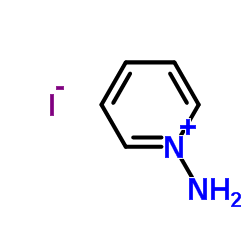Ethyl pyrazolo[1,5-a]pyridine-3-carboxylate
Modify Date: 2024-01-04 15:44:55
![Ethyl pyrazolo[1,5-a]pyridine-3-carboxylate Structure](https://image.chemsrc.com/caspic/410/16205-44-0.png)
Ethyl pyrazolo[1,5-a]pyridine-3-carboxylate structure
|
Common Name | Ethyl pyrazolo[1,5-a]pyridine-3-carboxylate | ||
|---|---|---|---|---|
| CAS Number | 16205-44-0 | Molecular Weight | 190.19900 | |
| Density | 1.22g/cm3 | Boiling Point | 134-135ºC/3mm | |
| Molecular Formula | C10H10N2O2 | Melting Point | N/A | |
| MSDS | N/A | Flash Point | N/A | |
| Name | Ethyl pyrazolo[1,5-a]pyridine-3-carboxylate |
|---|---|
| Synonym | More Synonyms |
| Density | 1.22g/cm3 |
|---|---|
| Boiling Point | 134-135ºC/3mm |
| Molecular Formula | C10H10N2O2 |
| Molecular Weight | 190.19900 |
| Exact Mass | 190.07400 |
| PSA | 43.60000 |
| LogP | 1.51100 |
| Index of Refraction | 1.594 |
Synonym:None know Section 2 - COMPOSITION, INFORMATION ON INGREDIENTS
Risk Phrases: 22 36/37/38 Section 3 - HAZARDS IDENTIFICATION EMERGENCY OVERVIEW
Harmful if swallowed. Irritating to eyes, respiratory system and skin. Potential Health Effects Eye: Causes eye irritation. Skin: Causes skin irritation. Ingestion: Harmful if swallowed. May cause irritation of the digestive tract. Inhalation: Causes respiratory tract irritation. Chronic: No information found. Section 4 - FIRST AID MEASURES Eyes: Flush eyes with plenty of water for at least 15 minutes, occasionally lifting the upper and lower eyelids. Get medical aid. Skin: Get medical aid. Flush skin with plenty of water for at least 15 minutes while removing contaminated clothing and shoes. Ingestion: Get medical aid. Do NOT induce vomiting. If conscious and alert, rinse mouth and drink 2-4 cupfuls of milk or water. Inhalation: Remove from exposure and move to fresh air immediately. If not breathing, give artificial respiration. If breathing is difficult, give oxygen. Get medical aid. Notes to Physician: Section 5 - FIRE FIGHTING MEASURES General Information: As in any fire, wear a self-contained breathing apparatus in pressure-demand, MSHA/NIOSH (approved or equivalent), and full protective gear. Extinguishing Media: Use water spray, dry chemical, carbon dioxide, or chemical foam. Section 6 - ACCIDENTAL RELEASE MEASURES General Information: Use proper personal protective equipment as indicated in Section 8. Spills/Leaks: Absorb spill with inert material (e.g. vermiculite, sand or earth), then place in suitable container. Avoid runoff into storm sewers and ditches which lead to waterways. Section 7 - HANDLING and STORAGE Handling: Use with adequate ventilation. Avoid breathing dust, vapor, mist, or gas. Avoid contact with skin and eyes. Storage: Store in a cool, dry place. Store in a tightly closed container. Section 8 - EXPOSURE CONTROLS, PERSONAL PROTECTION Engineering Controls: Facilities storing or utilizing this material should be equipped with an eyewash facility and a safety shower. Use adequate ventilation to keep airborne concentrations low. Exposure Limits CAS# 16205-44-0: Personal Protective Equipment Eyes: Wear chemical splash goggles. Skin: Wear appropriate protective gloves to prevent skin exposure. Clothing: Wear appropriate protective clothing to prevent skin exposure. Respirators: Follow the OSHA respirator regulations found in 29 CFR 1910.134 or European Standard EN 149. Use a NIOSH/MSHA or European Standard EN 149 approved respirator if exposure limits are exceeded or if irritation or other symptoms are experienced. Section 9 - PHYSICAL AND CHEMICAL PROPERTIES Physical State: Oil Color: Yellow Odor: Not available. pH: Not available. Vapor Pressure: Not available. Viscosity: Not available. Boiling Point: Not available. Freezing/Melting Point: Not available. Autoignition Temperature: Not available. Flash Point: Not available. Explosion Limits, lower: Not available. Explosion Limits, upper: Not available. Decomposition Temperature: Solubility in water: Specific Gravity/Density: Molecular Formula: C10H10N2O2 Molecular Weight: 190.2 Section 10 - STABILITY AND REACTIVITY Chemical Stability: Stable under normal temperatures and pressures. Conditions to Avoid: Incompatible materials. Incompatibilities with Other Materials: Strong oxidizing agents. Hazardous Decomposition Products: Carbon monoxide, oxides of nitrogen, carbon dioxide. Hazardous Polymerization: Has not been reported Section 11 - TOXICOLOGICAL INFORMATION RTECS#: CAS# 16205-44-0 unlisted. LD50/LC50: Not available. Carcinogenicity: Ethyl pyrazolo[1,5-a]pyridine-3-carboxylate - Not listed by ACGIH, IARC, or NTP. Section 12 - ECOLOGICAL INFORMATION Section 13 - DISPOSAL CONSIDERATIONS Dispose of in a manner consistent with federal, state, and local regulations. Section 14 - TRANSPORT INFORMATION IATA Shipping Name: Not regulated. Hazard Class: UN Number: Packing Group: IMO Shipping Name: Not regulated. Hazard Class: UN Number: Packing Group: RID/ADR Shipping Name: Not regulated. Hazard Class: UN Number: Packing group: Section 15 - REGULATORY INFORMATION European/International Regulations European Labeling in Accordance with EC Directives Hazard Symbols: XN Risk Phrases: R 22 Harmful if swallowed. R 36/37/38 Irritating to eyes, respiratory system and skin. Safety Phrases: S 23 Do not inhale gas/fumes/vapour/spray. S 26 In case of contact with eyes, rinse immediately with plenty of water and seek medical advice. S 36/37/39 Wear suitable protective clothing, gloves and eye/face protection. WGK (Water Danger/Protection) CAS# 16205-44-0: No information available. Canada None of the chemicals in this product are listed on the DSL/NDSL list. CAS# 16205-44-0 is not listed on Canada's Ingredient Disclosure List. US FEDERAL TSCA CAS# 16205-44-0 is not listed on the TSCA inventory. It is for research and development use only. SECTION 16 - ADDITIONAL INFORMATION N/A |
| Hazard Codes | Xi:Irritant; |
|---|---|
| HS Code | 2933990090 |
|
~71% ![Ethyl pyrazolo[1,5-a]pyridine-3-carboxylate Structure](https://image.chemsrc.com/caspic/410/16205-44-0.png)
Ethyl pyrazolo[... CAS#:16205-44-0 |
| Literature: Loeber; Huebner; Utz; Gmeiner Journal of Medicinal Chemistry, 2001 , vol. 44, # 17 p. 2691 - 2694 |
| Precursor 2 | |
|---|---|
| DownStream 10 | |
| HS Code | 2933990090 |
|---|---|
| Summary | 2933990090. heterocyclic compounds with nitrogen hetero-atom(s) only. VAT:17.0%. Tax rebate rate:13.0%. . MFN tariff:6.5%. General tariff:20.0% |
| MFCD06411542 |
| ETHYL PYRAZOLO[1,5-A]PYRIDINE-3-CARBOXYLATE |


![4,5,6,7-Tetrahydropyrazolo[1,5-a]pyridine-3-carbaldehyde structure](https://image.chemsrc.com/caspic/326/307308-03-8.png) CAS#:307308-03-8
CAS#:307308-03-8![pyrazolo[1,5-a]pyridine-7-carbaldehyde structure](https://image.chemsrc.com/caspic/489/362661-83-4.png) CAS#:362661-83-4
CAS#:362661-83-4![3-[[4-(4-chlorophenyl)piperazin-1-yl]methyl]pyrazolo[1,5-a]pyridine structure](https://image.chemsrc.com/caspic/435/221470-50-4.png) CAS#:221470-50-4
CAS#:221470-50-4![pyrazolo[1,5-a]pyridine-3-carbonitrile structure](https://image.chemsrc.com/caspic/257/25627-89-8.png) CAS#:25627-89-8
CAS#:25627-89-8 CAS#:274-56-6
CAS#:274-56-6![pyrazolo[1,5-a]pyridine-3-carbaldehyde structure](https://image.chemsrc.com/caspic/142/73957-66-1.png) CAS#:73957-66-1
CAS#:73957-66-1![3-Bromo-pyrazolo[1,5-a]pyridine structure](https://image.chemsrc.com/caspic/117/5910-12-3.png) CAS#:5910-12-3
CAS#:5910-12-3![Pyrazolo[1,5-a]pyridin-3-ylmethanol structure](https://image.chemsrc.com/caspic/149/117782-76-0.png) CAS#:117782-76-0
CAS#:117782-76-0![Pyrazolo[1,5-a]pyridine-3-carboxylic acid structure](https://image.chemsrc.com/caspic/334/16205-46-2.png) CAS#:16205-46-2
CAS#:16205-46-2![3-(tetramethyl-1,3,2-dioxaborolan-2-yl)pyrazolo[1,5-a]pyridine structure](https://image.chemsrc.com/caspic/126/1207557-48-9.png) CAS#:1207557-48-9
CAS#:1207557-48-9